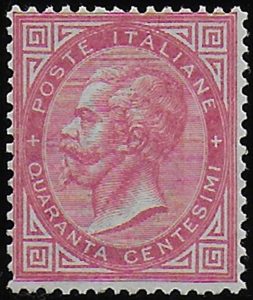Francobolli del Regno d’Italia

Il 10 gennaio 1859 a Torino, Vittorio Emanuele II, re di Sardegna pronunciò il celebre discorso che diede avvio alla seconda Guerra d’Indipendenza Italiana.
“Il nostro paese, piccolo per territorio, acquistò credito nei Consigli d’Europa perché grande per le idee che rappresenta, per le simpatie che esso ispira. Questa condizione non è scevra di pericoli, giacché, nel mentre rispettiamo i trattati, non siamo insensibili al grido di dolore che da tante parti d’Italia si leva verso di noi!”
Per l’Austria, il riferimento al Lombardo- Veneto e al fervore dell’opinione pubblica patriottica in quella regione, fu un affrontò. Decise così di inviare il 3° Corpo a sostegno delle truppe stanziate nel Nord d’Italia. La forte concentrazione di truppe piemontesi e di volontari sul confine lombardo, indusse Vienna a inoltrare un ultimatum al Regno Sabaudo con l’ingiunzione di disarmare le truppe entro tre giorni. Fu l’occasione che il primo ministro Cavour aspettava. I patti segreti, stipulati fra Piemonte e Francia a Plombières, prevedevano, infatti, un intervento francese al fianco del Piemonte solo in caso di aggressione da parte degli austriaci. Intanto gli echi del discorso accesero la miccia della ricolta in tutta la penisola: i lombardi manifestarono il loro entusiasmo, mentre i volontari passarono il Ticino per unirsi all’esercito sabaudo. La seconda guerra d’Indipendenza italiana ebbe inizio.
Nel 1859-60 non si poteva più parlare di Regno di Sardegna ma di Stato Italiano. A seguito della guerra con l’Austria, gli Stati Sardi avevano conquistato gran parte del territorio dell’Italia settentrionale. Garibaldi con la conquista del Regno delle due Sicilie costrinse re Vittorio Emanuele II, per scongiurare un intervento francese in difesa del Papa, ad occupare nuovi territori pontefici per bloccare la sua Marcia su Roma. Il 17 dicembre del 1860 a seguito dei Plebisciti in Abruzzi, Campania, Basilicata, Calabria, Sicilia e, nel novembre dello stesso anno, anche in Umbria e Marche, queste regioni vennero dichiarate “parte integrale dello Stato Italiano“. Contemporaneamente viene sciolto il Parlamento Subalpino ed indette le prime elezioni italiane. Il 18 febbraio si riunisce a Torino il nuovo Parlamento italiano che offre a Vittorio Emanuele II la corona del nuovo Regno costituito. Il 20 febbraio Il Re tenne il celebre discorso della Corona che così recita:
“Signori Senatori! Signori Deputati!
Libera ed unita quasi tutta, per mirabile aiuto della divina Provvidenza, per la concorde volontà dei popoli, e per lo splendido valore degli eserciti, l’Italia confida nella virtù e nella sapienza vostra.
A voi si appartiene il darle istituti comuni e stabile assetto. Nello attribuire le maggiori libertà amministrative a popoli che ebbero consuetudini ed ordini diversi veglierete perché l’unità politica, sospiro di tanti secoli, non possa mai essere menomata. L’opinione delle genti civili ci è propizia; ci sono propizi gli equi e liberali principii che vanno prevalendo nei Consigli d’Europa. L’Italia diventerà per essa una guarentigia di ordine e di pace, e ritornerà efficace stromento della civiltà universale”.
Il 1° marzo dello stesso anno nascono le Poste Italiane, un servizio di posta unificato con nuove strutture, servizi e norme di funzionamento comuni.
Durante i primi mesi dell’unificazione i francobolli in uso erano ancora quelli del Regno di Sardegna e la prima vera serie italiana è normalmente considerata la Prima emissione dentellata del 1862 che venne realizzata aggiungendo la dentellatura alla quarta emissione del Regno di Sardegna. Nel maggio del 1862 fu approvata la nuova Legge postale che unificava a 15 c. la tariffa per le lettere e favoriva l’affrancatura, ponendo al doppio la tassa per la corrispondenza non franca. Nel relativo Regolamento di attuazione fu prevista l’emissione di una serie di 8 francobolli recanti al centro lo stemma sabaudo. L’1 gennaio del 1863 venne emesso un francobollo da 15 c., valore complementare per la nuova tariffa interna, con al centro l’effigie di Vittorio Emanuele II in rilievo, tipo Matraire.
Seguirono numerose altre emissioni, per citarne alcune:
- 1º gennaio 1863 Segnatasse con la Cifra in Ovale;
- 10 febbraio 1863 15 centesimi litografico;
- 1º dicembre 1863 Prima serie definitiva (De La Rue);
- 1º gennaio 1865 Soprastampa ferro di cavallo;
I francobolli del Regno d’Italia sono quelle emissioni diffuse da Poste italiane a partire dall’unificazione della Nazione, avvenuta nel 1861 con la convocazione del primo parlamento italiano, fino all’avvento della Repubblica Italiana nel 1946. Possono quindi distinguersi 4 periodi in base al regnante di riferimento: Vittorio Emanuele II, Umberto I, Vittorio Emanuele III ed Umberto II.
Le collezioni di Regno d’Italia rimangono tra le più belle nel mondo della filatelia.
C.M.
On 10 January 1859 in Turin, Victor Emmanuel II, King of Sardinia delivered the famous speech that started the second Italian War of Independence.
‘Our country, small in territory, acquired credit in the Councils of Europe because it is great for the ideas it represents, for the sympathies it inspires. This condition is not without dangers, since, while we respect the treaties, we are not insensitive to the cry of pain that rises from so many parts of Italy towards us!”
For Austria, the reference to Lombardo-Veneto and the fervour of patriotic public opinion in that region was a challenge. Thus it decided to send the 3rd Corps to support the troops stationed in northern Italy. The heavy concentration of Piemontese troops and volunteers on the Lombard border led Vienna to issue an ultimatum to the Kingdom of Savoy with the injunction to disarm the troops within three days. It was the opportunity that Prime Minister Cavour had been waiting for. The secret pacts, stipulated between France and Piemonte at Plombières, foresaw, in fact, a French intervention at Piedmont’s side only in the event of aggression by the Austrians. Meanwhile, the echoes of the speech lighted the spark of the uprising throughout the peninsula: the Lombards showed their enthusiasm, while volunteers crossed the Ticino to join the Savoy army. The second Italian War of Independence began.
In 1859-60, one could no longer speak of a Kingdom of Sardinia but of an Italian State. Following the war with Austria, the Sardinian States had conquered a large part of the territory of northern Italy. Garibaldi with the conquest of the Kingdom of the Two Sicilies forced King Victor Emmanuel II, in order to avert a French intervention in defence of the Pope, to occupy new papal territories to block his March on Rome. On 17 December 1860, following plebiscites in Abruzzi, Campania, Basilicata, Calabria, Sicily and, in November of the same year, also in Umbria and Marche, these regions were declared ‘an integral part of the Italian State’. At the same time, the Subalpine Parliament was dissolved and the first Italian elections were called. On 18 February, the new Italian Parliament met in Turin and offered Victor Emmanuel II the crown of the newly formed Kingdom. On 20 February, the King gave the famous Speech of the Crown, which read as follows:
“Gentlemen Senators! Gentlemen Deputies!
Free and united almost entirely, by the admirable help of divine Providence, by the concordant will of the peoples, and by the splendid valour of the armies, Italy trusts in your virtue and wisdom.
To you belongs the giving of common institutions and a stable order. In attributing the greatest administrative freedoms to peoples who have had different customs and orders, you will see to it that the political unity, the sigh of so many centuries, may never be undermined. The opinion of civilised peoples is favourable to us; the fair and liberal principles that are prevailing in the Councils of Europe are favourable to us. Italy will become for it a guarentage of order and peace, and will return an effective instrument of universal civilisation’.
On 1 March of the same year, the Italian Post Office was created, a unified postal service with new structures, services and common operating rules.
During the first months of unification, the postage stamps in use were still those of the Kingdom of Sardinia, and the first real Italian series is usually considered the First perforated issue of 1862, which was made by adding perforation to the fourth issue of the Kingdom of Sardinia. In May 1862, the new Postal Law was approved, which unified the tariff for letters to 15 c. and favoured franking, setting the fee for non-franked mail at double that amount. The relevant implementing regulation provided for the issue of a set of 8 stamps bearing the Savoy coat of arms in the centre. On 1 January 1863, a 15 c. stamp was issued, a complementary value for the new domestic rate, with the effigy of Victor Emmanuel II in relief in the centre, Matraire type.
Numerous other issues followed, to name a few:
- 1 January 1863 Postage due stamps with the Oval numeral;
- 10 February 1863 15 centimes lithographic;
- 1 December 1863 First definitive series (De La Rue);
- 1 January 1865 Overprinted horseshoe;
The postage stamps of the Kingdom of Italy are those issues released by the Italian Post Office from the unification of the Nation in 1861 with the convocation of the first Italian Parliament, until the advent of the Italian Republic in 1946. Four periods can therefore be distinguished on the basis of the relevant ruler: Victor Emmanuel II, Umberto I, Victor Emmanuel III and Umberto II.
The Kingdom of Italy collections remain among the finest in the world of philately.
C.M.


